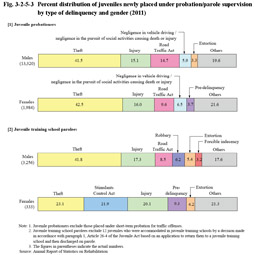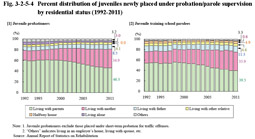1 Juvenile probationers/parolees
(1) Number of juveniles newly placed under probation/parole supervision, etc.
Fig. 3-2-5-1 shows the number of juvenile probationers and juvenile training school parolees newly placed under probation/parole supervision since 1949. The number of juvenile probationers newly placed under probation reached a record high level in 1990 at 73,779, but then turned to a decreasing trend, and was 23,580 in 2011 (down 7.6% from the previous year). The number of juvenile training school parolees newly placed under parole supervision increased from 1997 to be 5,848 persons in 2002. It then, however, turned to follow a decreasing trend, and was 3,601 in 2011 (down 7.3% (id.)) (See Appendix 2-12).
Fig. 3-2-5-1 Number of juveniles newly placed under probation/parole supervision (1949-2011)
(2) Characteristics of juvenile probationers/parolees
a. Age
Fig. 3-2-5-2 shows the percent distribution of juvenile probationers (excluding those placed under short-term probation for traffic offenses; hereinafter the same in this section) and juvenile training school parolees newly placed under probation/parole supervision in 2011 by age group.
Fig. 3-2-5-2 Percent distribution of juveniles newly placed under probation/parole supervision by age group (2011)
b. Type of delinquency
Fig. 3-2-5-3 shows the percent distribution of juveniles newly placed under probation/parole supervision in 2011 by type of delinquency and gender.
Fig. 3-2-5-3 Percent distribution of juveniles newly placed under probation/parole supervision by type of delinquency and gender (2011)
c. Residential status
Fig. 3-2-5-4 shows the percent distribution of juveniles newly placed under probation/parole supervision by residential status over the last 20 years. The proportion of those “living with parents” was declining while that of “living with mother” was on a rising trend with respect to both juvenile probationers and juvenile training school parolees.
Fig. 3-2-5-4 Percent distribution of juveniles newly placed under probation/parole supervision by residential status (1992-2011)
d. Educational/employment status
Fig. 3-2-5-5 shows the percent distribution of juvenile probationers and juvenile training school parolees by educational/employment status at the time of the commencement/termination of their probation/parole supervision in 2011. Although not strictly speaking an exact comparison, as those whose probation/parole supervision commenced and those whose probation/parole supervision terminated the same year were not necessarily the same person, the proportion of those employed was higher at the time of termination of their probation/parole supervision than at the time of commencement with both juvenile probationers and juvenile training school parolees. However, 10.9% of all juvenile probationers and 18.4% of all juvenile training school parolees were still unemployed at the termination of their probation/parole supervision.
Fig. 3-2-5-5 Percent distribution of juvenile probationers/juvenile training school parolees by educational/employment status at the time of commencement/termination of their probation/parole supervision (2011)




